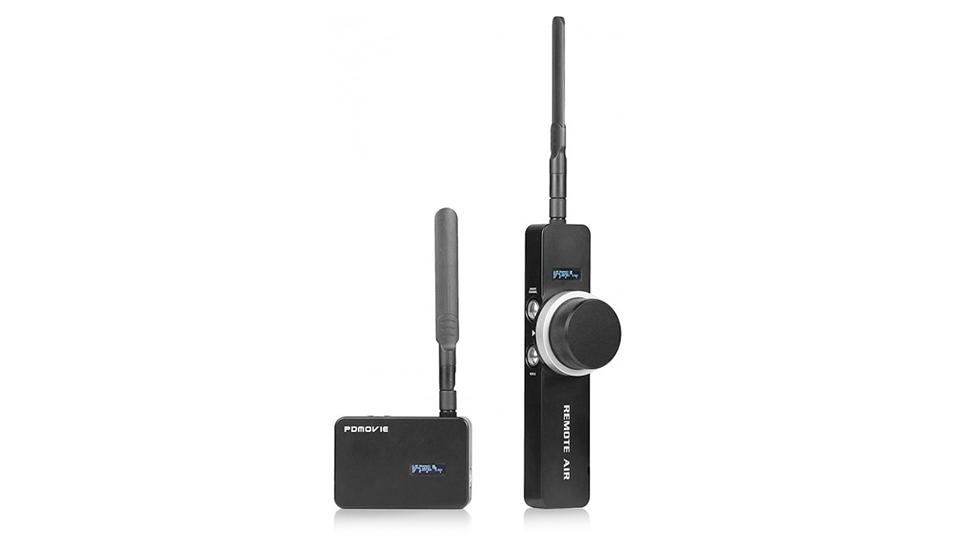One of the unsung heroes of the film industry is the focus puller. It doesn’t matter how great the camera movement, lighting, or acting is if the image on the screen is out of focus. Traditionally, the focus puller, or 1st Assistant Camera (AC), operates on the side of the camera, using a follow focus to mark spots and “pull focus” to follow the action/subject. In many cases it isn’t too difficult for the camera assistant to move along with the camera, but when the director calls for complex shots on jibs, dollies, stabilizers, or motorized gimbal systems such as the M¨VI, it often becomes physically impossible to be beside the camera. In such cases, you need to start considering a wireless follow focus system, such as the PD Movie Remote Air from ikan.
With PD Movie Remote Air Wireless Follow Focus Systems, you can pull focus, zoom, or aperture remotely and precisely from up to 300′ away. The system operates on the 2.4 GHz frequency band, with 20 channels to choose from to prevent interference, and features automatic lens calibration. The system comes in two basic flavors: single channel, single-motor kits or dual channel, two-motor kits. The kits consists of a hand unit/transmitter with focus wheel, a receiver, and a drive motor (two drive motors for the dual-channel kit), with each piece constructed of extruded aluminum.?
The motor unit mounts on a single 19mm rod, or 15mm rod using the included adapter sleeve, and can be reversed easily for increased flexibility or when working with shorter lenses. The unit uses an industry-standard 0.8 pitch drive gear for compatibility with cine-style lenses, or DSLR lenses with a 0.8 pitch-gear ring attached. Sliding adjustments on the motor allow for easy mating of the gear drive with the lens.
Both the single- and dual-channel kits are available with either standard or high-torque motors. The standard motor is suitable for use with cinema primes, lightweight zoom lenses, or infinitely rotating DSLR lenses, while the high torque motor is useful for heavy zoom lenses or stiff/older cinema lenses. The motors use professional 10-pin to 10-pin LEMO connectors, with 29″ long cables, provided to give you plenty of room to mount the receivers in a variety of locations on your rig. The receiver unit accepts 12 VDC power from your existing professional battery using the included 4-pin to P-Tap cable.
“…you can pull focus, zoom, or aperture remotely and precisely from up to 300′ away.”
The lightweight hand unit provides the wireless control for the motors. It features foldable, flexible antennas, easy access buttons, and an OLED display with blue readout indicating the channel, connection strength, and battery level. A rechargeable lithium-ion battery provides up to 30 hours on a single charge, so you shouldn’t have to worry about it running out of juice during a shoot, unless you forgot to charge it the night before, using the included USB wall charger. The hand unit has 1/4″-20 threaded holes for mounting it on a stand or tripod but, more often than not, you’ll be using it handheld.
Once you have everything set up and your receiver and hand unit are set to the same channel, the system can automatically calibrate to your cine-style lens in a matter of seconds; simply press and hold the “Nerve” button on the hand unit and the system will find both the beginning and the ending stops of the focus adjustment range, then it returns to a center point. After that, you’re ready to go. For DSLR lenses that rotate infinitely, you can manually map A and B stops. The system will also re-map the short throw of DSLR lenses to the full range of the focus wheel for more precise and controlled focus pulls. Another useful feature is the ability to change the motor direction when using lenses that rotate in the opposite direction of most, such as Nikon lenses.
With your lens mapped, you’re ready to control your motor using the aluminum focus wheel on the hand unit. Full-duplex signal processing ensures that there is instant reaction from the focus wheel to the motor, so you won’t have to worry about any delay when hitting your focus marks. The wheel is attached to the hand unit via rare earth magnets and can be marked using a grease pencil or detached to add marking tape along the side.
The hand unit included with the dual-channel system has an inner dial, in addition to the main focus wheel, for controlling a second motor; either standard or high torque. This gives you wireless control of focus and zoom, or focus and aperture at your fingertips. The entire kits?fit inside an included water-resistant polypropylene hard case with custom-cut foam, O-ring gasket, and pressure-relief valve with cables.
The Remote Air (PD Movie)?from ikan is ideal for assistant camera operators looking for a complete wireless follow focus system that is easy to use, and ready out of the box to?help you hit those crucial focus marks on even?the most?demanding shots.
Wireless
Frequency: 2.4 GHzChannels: 20
Marking Ring
Aluminum (use grease pencil)
Connectors
Receiver1 x 4-pin Lemo for power1 x 10-pin Lemo connection to motor 11 x 10-pin Lemo connection to motor 2
Remote Handwheel1 x 4-pin Lemo (power charging)
Battery
Transmitter Rechargeable Lithium-ionApproximately 30 hours per charge
Motor
Type: Standard or High TorqueMotor CableConnectors: 10-pin Lemo male/femaleLength: 28″ (71.12 cm)
Hard Case
Water Repellent, Polypropylene Construction, O-Ring Seal, Pre-cut foam, Pressure-relief valve
Dimensions
Transmitter: 8.25 x 2.5 x 3.1″ (20.96 x 6.35 x 7.87 cm)Receiver: 3.75 x 2.25 x 0.75″ (9.53 x 5.72 x 1.91 cm)Hard Case: 15.25 x 12.25 x 4.5″ (38.74 x 35.12 x 11.43 cm)


